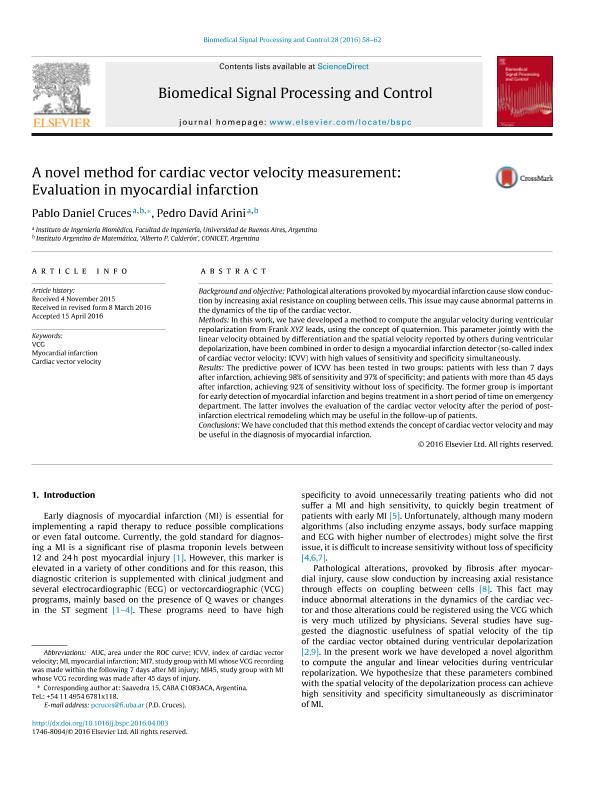Mostrar el registro sencillo del ítem
dc.contributor.author
Cruces, Pablo Daniel

dc.contributor.author
Arini, Pedro David

dc.date.available
2018-03-12T19:44:22Z
dc.date.issued
2016-07
dc.identifier.citation
Cruces, Pablo Daniel; Arini, Pedro David; A novel method for cardiac vector velocity measurement: Evaluation in myocardial infarction; Elsevier; Biomedical Signal Processing and Control; 28; 7-2016; 58-62
dc.identifier.issn
1746-8094
dc.identifier.uri
http://hdl.handle.net/11336/38572
dc.description.abstract
Background and objective: Pathological alterations provoked by myocardial infarction cause slow conduction by increasing axial resistance on coupling between cells. This issue may cause abnormal patterns in the dynamics of the tip of the cardiac vector. Methods: In this work, we have developed a method to compute the angular velocity during ventricular repolarization from Frank XYZ leads, using the concept of quaternion. This parameter jointly with the linear velocity obtained by differentiation and the spatial velocity reported by others during ventricular depolarization, have been combined in order to design a myocardial infarction detector (so-called index of cardiac vector velocity: ICVV) with high values of sensitivity and specificity simultaneously. Results: The predictive power of ICVV has been tested in two groups: patients with less than 7 days after infarction, achieving 98% of sensitivity and 97% of specificity; and patients with more than 45 days after infarction, achieving 92% of sensitivity without loss of specificity. The former group is important for early detection of myocardial infarction and begins treatment in a short period of time on emergency department. The latter involves the evaluation of the cardiac vector velocity after the period of post-infarction electrical remodeling which may be useful in the follow-up of patients. Conclusions: We have concluded that this method extends the concept of cardiac vector velocity and may be useful in the diagnosis of myocardial infarction.
dc.format
application/pdf
dc.language.iso
eng
dc.publisher
Elsevier

dc.rights
info:eu-repo/semantics/openAccess
dc.rights.uri
https://creativecommons.org/licenses/by-nc-nd/2.5/ar/
dc.subject
Cardiac Vector Velocity
dc.subject
Myocardial Infarction
dc.subject
Vcg
dc.subject.classification
Ingeniería de Sistemas y Comunicaciones

dc.subject.classification
Ingeniería Eléctrica, Ingeniería Electrónica e Ingeniería de la Información

dc.subject.classification
INGENIERÍAS Y TECNOLOGÍAS

dc.title
A novel method for cardiac vector velocity measurement: Evaluation in myocardial infarction
dc.type
info:eu-repo/semantics/article
dc.type
info:ar-repo/semantics/artículo
dc.type
info:eu-repo/semantics/publishedVersion
dc.date.updated
2018-03-12T18:15:57Z
dc.journal.volume
28
dc.journal.pagination
58-62
dc.journal.pais
Países Bajos

dc.journal.ciudad
Amsterdam
dc.description.fil
Fil: Cruces, Pablo Daniel. Consejo Nacional de Investigaciones Científicas y Técnicas. Oficina de Coordinación Administrativa Saavedra 15. Instituto Argentino de Matemática Alberto Calderón; Argentina
dc.description.fil
Fil: Arini, Pedro David. Consejo Nacional de Investigaciones Científicas y Técnicas. Oficina de Coordinación Administrativa Saavedra 15. Instituto Argentino de Matemática Alberto Calderón; Argentina
dc.journal.title
Biomedical Signal Processing and Control

dc.relation.alternativeid
info:eu-repo/semantics/altIdentifier/doi/http://dx.doi.org/10.1016/j.bspc.2016.04.003
dc.relation.alternativeid
info:eu-repo/semantics/altIdentifier/url/https://www.sciencedirect.com/science/article/pii/S1746809416300350
Archivos asociados
